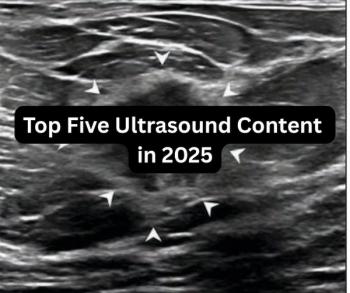
Is Radiology Part of the Physician Shortage?
Radiology’s place in the physician shortage.
When Diagnostic Imaging published a story on the
Though not much time has passed, the ground has shifted and radiologists are creeping back up in demand. This year, radiology landed on national physician search firm Merritt Hawkins’ top 20 search list for the first time since 2012.
“Demand for radiology diminished over the past decade due to a robust supply of residents entering the specialty, payment cuts for imaging services, and utilization suppression linked to both the recession and managed care, as well as the growing use of both domestic and offshore teleradiology services,” according to Merritt Hawkins’ 2016 Review of Physician and Advanced Practitioner Recruiting Incentives. But with an improving economy and aging population using more medical services, radiology is again on the rise. “In addition, despite new entrants to the field, close to 50% of radiologists are 55 and older and attrition is beginning to reduce the candidate pool.”
The Merritt Hawkins figure varies from the 2016 ACR Commission on Human Resources Workforce
The American Association of Medical Schools (AAMC) released a 2016
What Specialties Have Shortages?
In general, demand is growing faster than physician supply, according to Janis M. Orlowski, MD, chief health care officer of the AAMC. The need for surgeons has increased since their last report. “We’re noticing an increase in the shortage of surgeons, including general surgery, vascular surgery and neurosurgery,” she said. The total number of surgeons is decreasing.
Of course the need for primary care still exists, but some of that work has been taken up by nonphysician advanced practitioners. “We’re seeing the shortage of primary care doctors going down slightly and the need for specialists, including surgeons and psychiatrists, go up. There’s not an equal split as there had been in the past.” The AAMC did not break down the shortage of specialties like radiology, but lumped them together. Given that radiology wasn’t called out like surgery or psychiatry, Orlowski said one could assume that there are radiology shortages, but not as severe as surgery. There are only a few specialties with no shortage, including ophthalmology. “With the vast majority of specialties, there are shortages,” she said.
Why is There a Physician Shortage?
The reasons for the physician shortage hasn’t changed. “The number one reason is the aging of the population,” Orlowski said. Individuals over age 65 will increase by about 41% in the next ten years, and require more physician care and medical services. Like patients, the physicians as a group are aging too. In 2006, the AAMC called upon medical schools to increase enrollment and they’ve done so, with a 20%-25% increase in medical graduates since then. The goal is a 30% increase by
The 2016 residency match was the largest on record, according to the
Where are the Shortages?
While rural needs have outpaced urban recruiting in the past, that’s changing. Physician recruiting firms Medicus and Merritt Hawkins both report that recruiting among all specialties increased in urban areas in 2015.
Some health care systems also report significant shortages. The Veterans Administration system needs 1,600 physicians, said Orlowski. “They’re the canary in the coal mine.” At some VA facilities, 50% of clinical positions are unfilled, according to the Merritt Hawkins report.
Heath officials in Florida are also concerned. They looked at physician numbers two years ago, determining that in the next decade, the state will be short 7,000 physicians, said Orlowski. They’re now taking action to recruit and retain physicians. As part of the south, Florida’s needs are the rule, not the exception. Why? The south has more rural areas, said Orlowski.
“I think that physicians are attracted to areas with other physicians. We see that it’s difficult for physicians to maintain a practice and feel comfortable when practicing by themselves,” she said. They prefer to work in teams, including with other types of clinicians, like pharmacists and social workers.
Improving the Radiology Job Market
While a shortage of radiologists isn’t good for the health system, it is good for the radiology job market.
In the last year or so, it’s been easier for qualified radiologists to be pickier about their jobs, said Travis Singleton, a senior vice president of Merritt Hawkins. “It’s now much more favorable to be the radiologist than the employer. If you want to work, there are plenty of jobs.” It’s still not at a level where radiologists can name their price and desired practice or location, but it’s getting better. “For the most part, if you’re a subspecialist, which most young radiologists are, you can pretty much pick your road. It’s a much more favorable market. I don’t see that changing in the next year or two,” he said.
While subspecialist radiology training has been an essential part of the recent career track, Singleton doesn’t think it needs to continue that way. The younger generation of radiologists prefer getting subspecialty training, he said, but “for the health of the specialty, I hope that changes. The need is going to be in general radiology.” Currently, 90% of the radiologists coming out of training are subspecialized, and he thinks in the future it should be closer to 50%. “When you get into population health, you’re going to need some good old fashioned imaging help.” There’s a market for general radiologists, and compensation is starting to reflect that, he said.
The subspecialty training has impacted the make-up in the radiology field. The 2016 ACR Commission on Human Resources Workforce Survey showed that general radiologists are no longer the largest group of radiologists practicing, making up about 13% of the radiologist workforce.
The take-home message is that job opportunities for radiologists are improving. With more Americans able to access care through the Affordable Care Act, the aging population needing more diagnostic studies, and other population growth, flexible radiologists will find themselves with job opportunities.
Newsletter
Stay at the forefront of radiology with the Diagnostic Imaging newsletter, delivering the latest news, clinical insights, and imaging advancements for today’s radiologists.




























